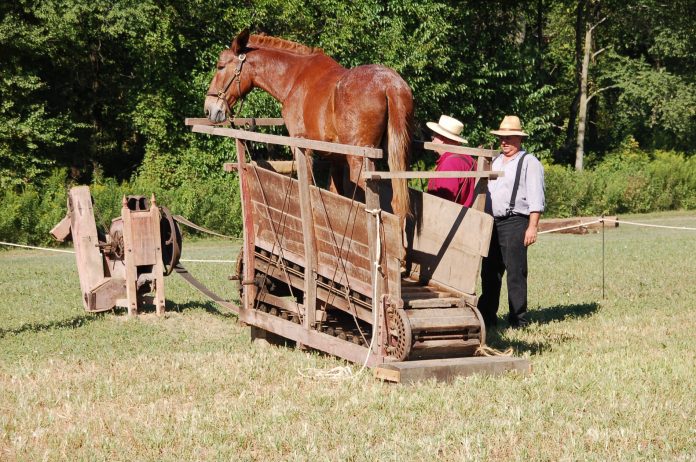Long before the internal combustion engine was perfected or steam power became popular, horses, mules, cattle, dogs, goats and even sheep, were pressed into service to supplement human brawn as a power source.
As long as the work consisted only of moving a machine from here to there, all that was needed was a strong draft animal or two and a suitable harness to connect the animal to the load.
On the other hand, converting an animal’s linear movement into rotary motion wasn’t quite so simple. The first machines that needed to be driven by rotary motion were gristmills, developed in the mid-east about 800 B.C. for grinding flour.
These mills were stationary and could be placed next to a stream or river which furnished the driving power through a water wheel. Gristmills could also be turned by windmills, the first recorded instance being in Rome before the time of Caesar Augustus.
When sawmills became popular, they too, were sited along a stream of water. Often, a single entrepreneur would build a gristmill and a sawmill side by side and folks from the surrounding area would carry or haul their grain and logs to him for processing.
Rotary motion
The impetus to find a better way to change the pulling power of animals into a rotary motion capable of driving machinery began in earnest with the development of threshing machines.
These machines, in answer to the laborious and time-consuming tasks of hand-flailing and winnowing grain, became popular in America by the 1820s. The early machines were operated by hand, usually with two to four men tugging and turning on cranks and levers, tedious jobs that required much muscle and sweat.
In 1826 it was said of Jacob Pope’s Massachusetts built threshers, that it was “harder work to turn the crank than to swing the flail.”
Barns were seldom close enough to a stream to allow the use of a water wheel and, while a farmer might have a windmill for pumping water, it wasn’t powerful or reliable enough to run a thresher.
Horse on platform
In 1822, a man named Howe patented a thresher with a vertical cylinder that was driven by a tethered horse walking on a large circular platform. As the platform revolved, a belt around its circumference drove a pulley on the vertical axle of the threshing cylinder.
Endless-track treadmills were the next step, having been invented in England in 1823, where initially, shackled prisoners provided the power. The first successful factory in America was Slater and Brown’s Cotton Mill that opened in Pawtucket, R.I. in 1790.
This factory, including the treadmill that powered the looms, is said to have been manned by children aged four to ten. So, treadmills weren’t new and, while at times, slaves, prisoners and children may have been used to run them, animals were more popular.
Most of the early “groundhog” threshers were powered by a horse or an ox on a tread power, but the new, combined thresher-fanning mills being developed by the Pitts brothers and others, required more power than the old treadmills could provide.
The Pitts brothers, John and Hiram, were itinerant threshermen who made many improvements to the “groundhog” threshers of the day, including an improved treadmill patented by Hiram in 1830.
Tread powers were built in many sizes, from small versions operated by a dog, a goat or a sheep, for running a small machine such as a butter churn, up to four-horse models to power large threshing machines or sawmills.
Tread power
All tread-powers, regardless of size, consisted of an inclined box, or pen, into which the animals were driven and tied. The floor of this pen was made up of an endless chain of cross planks, each of which was connected to each other, and to the drive pulley, by different arrangements of chains and rollers.
As the animals were made to walk upward and forward on the sloping “floor,” it moved to the rear and turned a belt pulley or a tumbling rod, or moved a lever which drove the machine.
These tread-powers could be mounted on wheels for portability, a feature popular with custom threshermen who moved from farm to farm. Tread powers were limited to, at most, four-horse units and not many of these larger versions were practical.
As threshing machines became larger and more sophisticated, with feed and straw conveyors, as well as the new “vibrators,” or straw walkers, more power was required and sweep powers were the answer, but that’s a story for another day.














We have an old horse power and a sheep power. Do you know if there is a market for these?